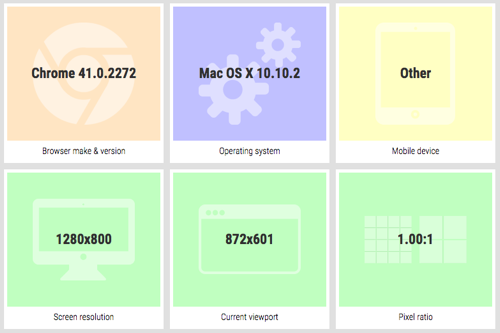Posts for June 2015
Is your website too slow for Google?

Google is constantly refining how it decides website rankings. The search giant continually tests new products, systems and ways of operating.
You might have seen recently that it introduced a 'mobile friendly' label to identify websites that display properly on mobile devices. It's also started prioritising these sites in mobile search results.
Now a new test suggests that slow websites could be penalised.
Google's red slow label
Earlier this year, a researcher stumbled upon what looked to be Google testing a new, red 'Slow' label next to certain websites on its results pages. And, more recently, a 'Slow to load' warning was spotted next to video content.
Although there's been no official word on this from Google, it's likely this is an early test for a new feature that could shake up search rankings.
And it would make sense. Google has long talked about the value it places on websites that load quickly, and it's well known that users get impatient when sites are slow to load.
The company has offered advice on how to improve your website's speed for quite a while, and load speed has affected rankings (in a minor way) since 2010.
This new red warning badge could be the push businesses need to review their website speed and take any necessary steps to improve.
How to test your website speed
Before you can work to speed up your website, it's a good idea to establish just how fast it is compared to other sites.
There are a number of tools to analyse your current site speed, set a benchmark, and look at ways in which you can improve:
If you already have Google Analytics on your site, you may have stumbled across the site speed reports, under the Behaviour heading. They provide good real-world results, but can take a while to update after you've made changes. Also, they may not provide enough data for small websites.
Google's PageSpeed Insights tests the desktop and the mobile versions of your website, scoring them out of 100. If you get 85 or above then that's very good. This is a good way to get an overview and recommendations to fix certain issues.
GTmetrix combines Google's PageSpeed with Yahoo's YSlow insight tool. This gives you a good benchmark and helps to identify bottlenecks in performance. This tool also provides more information about server speed, page load times, page size and more.
Between them, these three tools will give you a good understanding of how fast your website is. They should also be able to indicate where you should concentrate your efforts to see the best improvements.
If you're not technically minded, you might need to work with your website developer or hosting company to make many of the suggested improvements. But with these tools, you'll know where you stand — and you'll be able to avoid any red 'slow' labels in future.
(Don't forget, you can enter your competitors' website addresses into some of these tools, too, giving you a benchmark against their sites.)
© Nick Pinson, director at iWeb Solutions
Are you ready for Ofcom's UK Calling?
 The cost of phone calls is changing from July. In fact, this will be one of the biggest changes to the cost of UK telephone calls in a decade.
The cost of phone calls is changing from July. In fact, this will be one of the biggest changes to the cost of UK telephone calls in a decade.
Ofcom, the telecoms regulator, is calling the change 'UK Calling'. Is your business ready for it?
The confusing cost of calls
Last year, most businesses that serve consumers were banned from providing after-sales support via certain types of telephone number, including numbers starting 0845 and 0870.
However, many consumers are still forced to call these numbers. And there's considerable confusion about what they actually cost. People often end up facing unexpected bills, especially from mobile phones.
There's a plethora of numbers that start 08. What's more, people often don't realise that some numbers starting 07 are not mobile numbers, but are premium rate lines.
The latest changes plan to address this confusion.
The confusing cost of calls
From 1 July 2015, the cost of calling numbers that start 084, 087, 09 and 118 will be made up of two parts:
- An access charge: this goes to the phone company. It will be clear on bills and should be easy to understand when consumers take out a contract.
- A service charge: this is the rest of the call charge. The organisation being called decides how much this is. It must make the cost clear to consumers.
This change means consumers will be able to see how much money the organisation they're calling is making from the call. And that lets them decide whether they want to call – or, indeed, do business with them at all.
These rules will apply to all consumer calls to 084, 087, 09 and 118 numbers across the UK. It does not apply to old 0500 numbers.
The changes do not affect calls to ordinary landline numbers (01, 02, 03), mobile numbers (07), international calls, calls from payphones, or calls to the UK when roaming overseas.
In addition, all freephone numbers (starting 0800 or 0808) will be free to call from mobiles and landlines.
What you need to do
If your business uses one of the affected numbers, speak to the company that supplies it. They should be able to confirm the service charges you will face. You could end up with a higher bill than at present, particularly if you use an 0800 number.
The changes mean that now is a good time to think about whether you want to keep using these numbers, or if you'd prefer to switch to geographic numbers starting 01, 02 or 03.
You should also review all marketing literature, including websites, TV and radio adverts, point of sale materials and packaging.
If any of these materials show a number beginning 084, 087, 09 or 118, you must ensure that your service charge is clearly displayed.
As always, the rules say that ignorance is no excuse for not complying. You can get more information at Ofcom's UK Calling website.
© 2015 Dave Millet, from Equinox.
IT for Donuts: find your system information easily
 IT for Donuts is our regular feature where we explain a tech term or answer a question about business IT.
IT for Donuts is our regular feature where we explain a tech term or answer a question about business IT.
When you request help or technical support, you’ll often be asked to provide your computer’s system information. Here’s an easy way to get hold of this data
System information matters
Computers and software are complicated. With so many programs available in so many different versions, no two computers are set up quite the same.
Problems like system crashes can be caused by many things. When narrowing down the culprit, technical support agents will often ask for your system information. This includes details of how your computer is set up and what’s installed.
Having the system information makes it easier for them to suggest solutions and narrow down the likely cause of your problem.
But finding your system information can be tricky. Could you name which version of web browser you’re using, or the size of your screen resolution?
One place for system information
To avoid having to gather your system information piece by piece, you can visit the yourbrowser.is website.
When you go to this website, it reads some basic system information and shows it to you on the screen. This system information includes:
- Operating system and web browser versions
- Screen resolution and browse window size
- Whether you have key browser plugins installed
- Your time zone and language settings
The system information is displayed very clearly. You can also have it sent to you by email by entering your address.
What’s more, yourbrowser.is will let you create a customised version of this page that lives at a unique address and sends this information to you whenever someone visits it.
That makes it a handy way to gather key system information quickly.
The biggest threats to your business
What are the real digital threats to your business? When you’re thinking about IT security, it can be hard to know where you to focus your time and energy. (Believe everything you read in the news and there are dangers lurking around every corner!) To help companies understand the real risks out there, recruitment firm Modis has created this infographics explaining business security issues. It is a little US-centric, but we still think it contains some helpful information.

What’s Your Business’s Greatest Cyber Threat [Infographic] by the team at Modis



